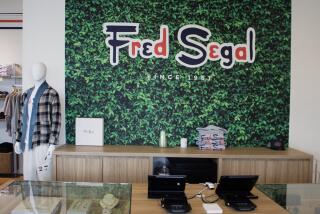Strategy Includes Lower Prices : Sears Shifts Gears, Going to More National Brands
For decades, anybody shopping at Sears for carpeting, car batteries or carpentry tools had only house brands to choose from. Now all that is starting to change.
This week Sears swept away the private-label carpeting at most of its 824 stores and laid in some of the hottest national brands around, including Du Pont’s Stainmaster, Monsanto’s Wear-Dated and 3M’s Stain Release.
Customers in the carpeting department are getting the first glimpse at what the “new” Sears will hold as the world’s largest retailer begins a dramatic shift in strategy, putting a much bigger emphasis on brand names and moving toward lower regular prices and away from frequent sales.
The carpets, for instance, are priced at “our lowest price every single day,” the retailer is saying in a burst of ads, and feature the Sears name and guarantee alongside the national manufacturer’s.
“I think it’s good,” said Mary Winn of Lomita as she browsed with a friend, Wanda Estrella, in the Sears carpet department Friday morning at Del Amo Fashion Center in Torrance. “And the prices are so reasonable, too.”
Big-Name Appliances Coming
More changes--many of which are being tested in Indianapolis, Wichita, Kan., Milwaukee and Richmond, Va.--will emerge in the next few months in Sears’ 43 Southland stores.
Sometime this year, for example, the merchant is expected to roll out Brand Central appliance and electronics departments, adding such big national brands as Amana, General Electric, Whirlpool, GoldStar, Hoover, Eureka, Sony and Panasonic to the familiar Kenmore and LXI house brands.
The concept has been tested in 13 Indianapolis stores since last summer and, a Sears spokesman said, has enabled Sears to increase its overall market share in these categories without hurting sales of house brands.
By year-end, men’s suits and other tailored clothing will be phased out, to be replaced by a new but unspecified “power format” in menswear. Shoppers will also see more brand names in garden and auto supplies, home furnishings and clothing and a new children’s concept. Eventually, signs in the stores and advertising will trumpet across-the-board price cuts.
Except for these few details, the company is keeping most information under wraps. “We don’t want to telegraph what we’re doing to our competitors,” said spokesman Philo K. Holland. (Observers speculate that the Sears strategy is still very much in the planning stage and that even Sears doesn’t know exactly what lies ahead.)
The absence of solid information is creating a bit of mystery around staid, old Sears, Roebuck & Co., something that hasn’t been there for quite awhile. About the only question there has been is why the vintage Chicago-based merchant has not moved sooner to turn around its flagging fortunes.
Last Oct. 31, amid a flurry of speculation that the lumbering company might become a takeover target, Sears announced the merchandising shift as part of an overhaul designed to boost its eroding profitability, improve its reputation with investors and win back shoppers who have strayed to specialty retailers and discount stores. The company also said it would sell its headquarters building, Sears Tower, and buy back 10% of its stock.
Industry observers see the merchandising strategy shift as by far the riskiest and most difficult element to pull off.
“Sears is going to have a real problem with this idea of putting Kenmore next to national brands,” said Carol Farmer, president of Carol Farmer Associates, a retail consulting firm in New York. “It’s going to be very difficult for Sears to make any money (because) the national brands are low margin.”
‘Comforting Cushion’
Kurt Barnard, publisher of the Retail Marketing Report newsletter in New York, said one of Sears’ biggest challenges will be educating its sales staff.
“Will they understand what it is they are selling?” he said. “Up till now, the Sears staff dealt with the comforting cushion of a famous name backed by a famous guarantee. They didn’t really have to sell (the products).”
The change envisioned by Sears is “not something that can be done instantly,” Barnard added. “It will take a great deal of work, training, indoctrination--a complete changeover in corporate policy and custom. It ain’t going to be easy.”
That view seems prevalent on Wall Street as well. Moody’s Investors Service this week lowered by two notches its rating of some of Sears’ long-term debt. “It’s going to be extremely challenging for them,” said Richard D. Mercier, a Moody’s retailing analyst. “You cannot expect them to do it quickly.”
One great unknown is how competitors will react. Montgomery Ward, run by Bernard F. Brennan, the brother of Sears Chairman Edward A. Brennan, already has made a big push into national brands and broke an advertising campaign touting “everyday low prices” as Sears was getting its new strategy under way.
Sears also is going up against powerhouse retailers such as Wal-Mart, K mart and Circuit City plus the nation’s vast network of specialty retailers, which have over the years stolen away Sears business in such prominent categories as sporting goods and bedding.
In the view of one retail industry observer, the battle will have to be fought in the trenches, and that means enlisting the sales staff to sell those national brands.
“The challenge to Sears is to effect what they want to do on the sales floor,” said Robert Kahn, publisher of the Retailing Today newsletter in Lafayette, Calif. “They can change the merchandise from headquarters, but they can’t change Sears’ interface with the customer simply by sending out a statement of new policy.”
More to Read
Inside the business of entertainment
The Wide Shot brings you news, analysis and insights on everything from streaming wars to production — and what it all means for the future.
You may occasionally receive promotional content from the Los Angeles Times.











